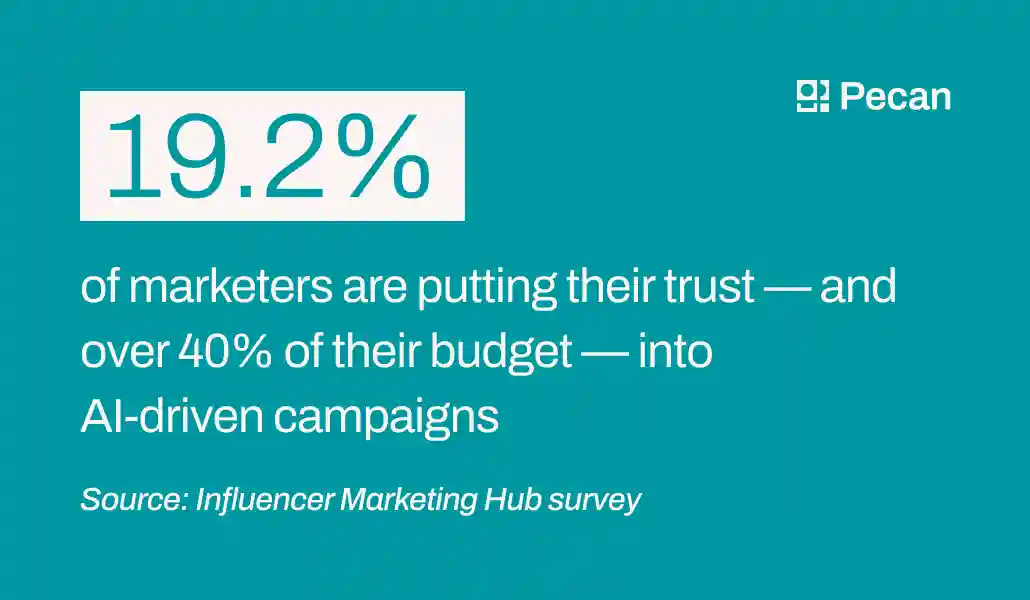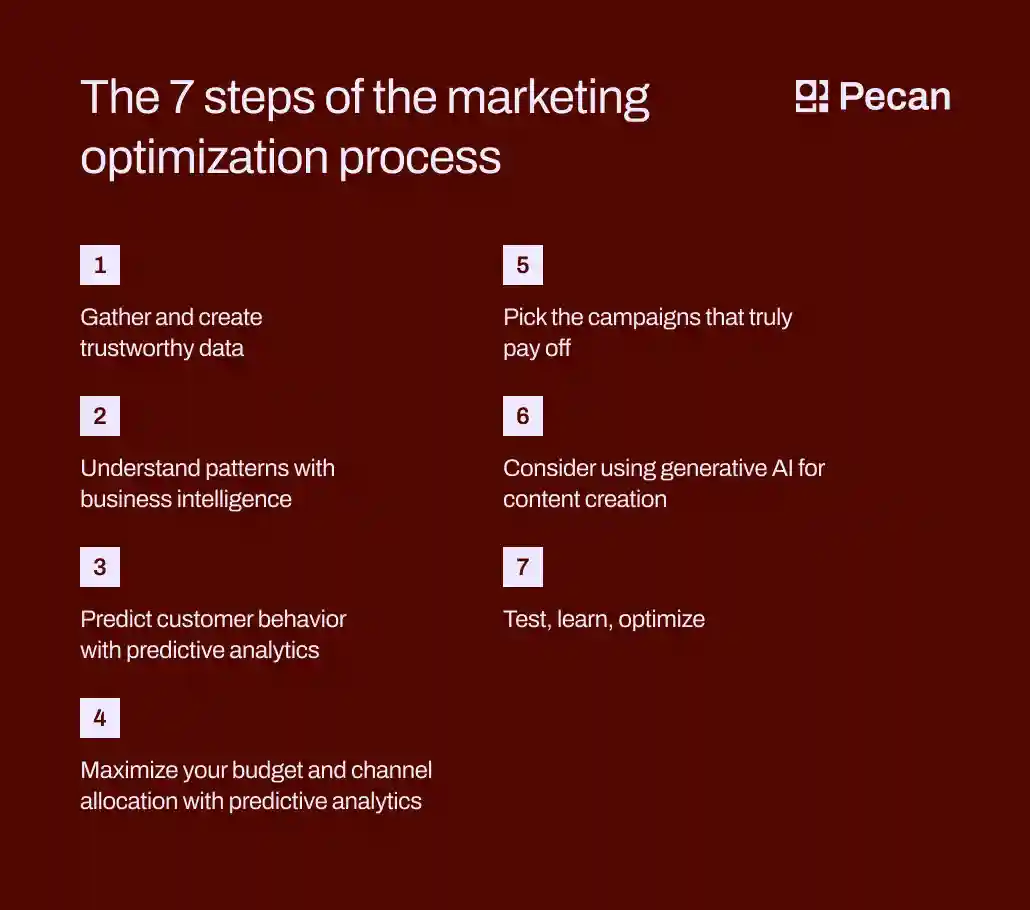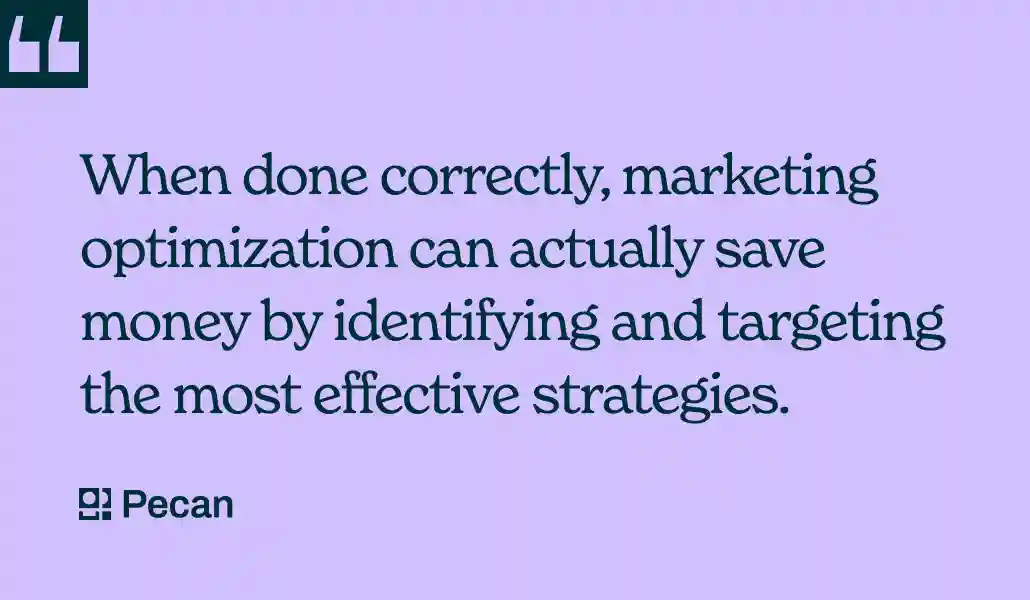In a nutshell:
- Marketing optimization is the process of making data-driven adjustments to your marketing efforts to better reach your business goals.
- Predictive analytics is an essential tool for marketing optimization, helping organizations make strategic decisions based on data.
- The 7 steps of an optimized marketing process include gathering trustworthy data; understanding patterns with business intelligence; predicting customer behavior with predictive analytics; maximizing budget and channel allocation; picking campaigns that pay off; considering generative AI for content creation; and testing, learning, and optimizing.
- Marketing optimization is essential to maximizing return on investment and should not be dismissed as overrated.
- Balancing marketing optimization with customer-centric strategies is crucial for sustainable business success.
It’s time to face the music: The marketing world is evolving at a breakneck pace, and if you're not harnessing the full power of your data and AI for marketing optimization, you might just get left behind.
In this guide, we peel back the layers of data-driven marketing optimization to help you conserve resources and boost your ROI — with a dash of AI innovation to spark new growth. Let’s get started.
What is marketing optimization?
Marketing optimization is the process of making adjustments to your marketing efforts based on data. Your data informs the marketing tools and tactics that you include in your marketing strategy. With this optimization, you can better reach your business goals.
But let's be honest. We've all heard that data-driven decision-making is the key to success. Yet, despite our best intentions and efforts, too many decisions in the marketing realm are still being made based on gut feelings, educated guesses, and past experience. With 88% of marketers believing their organization needs to increase its use of AI and automation to stay competitive, that simply won't cut it.
Predictive analytics is an essential tool for marketing optimization. It helps organizations transform decision-making from feeling like a coin flip into a surefire strategy backed by data. Predictive analytics goes beyond understanding past performance — it's about proactively understanding your audience and making strategic decisions that secure your success.
The Evolution of Marketing Optimization
Creativity and (some) risk-taking have their place in marketing — but not when it comes to marketing optimization. A survey by Influencer Marketing Hub shows that 19.2% of marketers are putting their trust — and over 40% of their budget — into AI-driven campaigns, highlighting the shift toward data-driven decision-making and personalization.
This is where predictive analytics steps in, using data, statistical algorithms, and machine learning to translate past performance into future events. Evaluating past behaviors and identifying patterns empowers marketers to predict customer actions, discern trends, and make preemptive decisions that give them a competitive edge.
Source: State of Predictive Analytics in Marketing 2022
Predictive analytics turns data into foresight, evolving your marketing team from reactive to proactive.
The 7 steps of the marketing optimization process
Unlocking the full potential of your marketing efforts necessitates a deep dive into the core elements that fuel predictive analytics success. In this section, we'll unravel the critical elements of an optimized marketing process, providing you with the insights and tools needed to elevate your strategies and ensure they are not just effective, but exceptional.
1. Gather and create trustworthy data
Clean, trustworthy data is a prerequisite to marketing optimization with predictive analytics. You also have to ensure your datasets inform your KPIs and marketing goals.
Start by establishing accurate data collection practices. Precision is key to fueling your predictive analytics tools. This will require accurate marketing measurement methods. Gather and aggregate data from all relevant sources, ensuring structured and unstructured data mix. Clean and preprocess your data to set the stage for actionable insights.
2. Understand patterns with business intelligence
Business intelligence (BI), including all your go-to reports and dashboards, is paramount to understanding what happened in the past. With them, marketers can recognize patterns and trends over time. But remember, what worked yesterday might not cut it tomorrow, and causation isn't always self-evident. While history’s great, when it comes to marketing, you can’t just live in the past — or else you’ll always be reactive. That’s where predictive analytics comes in.
3. Predict customer behavior with predictive analytics
Predictive analytics is the missing piece of your marketing analytics. Instead of just understanding the past, you can use AI-powered models to predict the future, things like customer lifetime value, return on ad spend (ROAS), and more. Here are a few ways predictive analytics can empower your brand to proactively shape customer engagement, not just react to trends.
Segment, predict, score, and thrive
Segment to shine: Use advanced clustering to understand customer behavior, tailoring your strategies for maximum impact.
Churn be gone: Don't wait for signs of customer departure — predict them. With predictive analytics, you can identify potential churn before it happens, crafting retention strategies that turn the tide and keep your customers loyal.
Score those leads: Enhance your conversion rates by using predictive analytics for lead scoring, focusing on high-potential prospects.
Sell more with organic sales: Analyze past purchases, recommend relevant products, and enhance customer satisfaction while boosting your bottom line.
Optimization station: Leverage insights to refine your campaigns and communication, ensuring each message resonates strongly and connects with your audience.
4. Maximize your budget and channel allocation with predictive analytics
Navigate the marketing landscape with a strategic approach to channel mix and budget allocation using predictive analytics and marketing mix modeling (MMM). They work together to ensure your marketing dollars are invested in the right places, delivering maximum performance and cost-efficiency.
MMM serves as your financial compass, ensuring that your budget is optimized across the right marketing channels (whether offline or digital marketing) for peak performance. Combining this with predictive analytics means you’re not just looking at past data — you’re using it to make informed decisions that align with customer needs and your overarching marketing objectives.
An example of marketing optimization
Take a company with an extensive marketing budget of over a billion dollars. They faced the challenge of optimizing their budget across more than 20 channels, particularly during an economic downturn. Pecan AI's predictive analytics platform stepped in, helping them use AI-driven MMM to navigate this challenge. The company managed to significantly enhance its marketing efficiency and operational margins without sacrificing revenue — a clear testament to the efficacy of marketing mix modeling.
The integration of MMM and predictive analytics into your marketing strategy equips you with the tools needed to make data-driven decisions. It ensures every dollar is well spent, yielding better results and higher efficiency.
5. Pick the campaigns that truly pay off
Now, let’s zero in on those high-rolling marketing campaigns. With predictive analytics, you can sift through historical data, spot patterns, and pinpoint which initiatives are destined for greatness.
Take KSG Mobile and Armor VPN as our guiding examples. They harnessed predictive analytics to calculate customer lifetime value, leading them to where to splash the cash in their marketing and where to hold back. The result? A big fat boost in return on ad spend and a practical lesson on the transformative power of predictive analytics in campaign selection. Here are the details:
Pecan's predictive analytics transformed KSG Mobile’s marketing strategy for their social casino games, providing a suite of predictive lifetime value (pLTV) models. These models delivered both immediate and long-term revenue insights across various channels and campaigns, enabling agile adjustments and strategic planning. The result? A radical improvement in campaign management efficiency, with the user acquisition team making quick, data-driven decisions and optimizing resources effectively.
These models delivered both immediate and long-term revenue insights across various channels and campaigns, enabling agile adjustments and strategic planning.
Armor VPN leveraged Pecan’s predictive analytics to sharpen its user acquisition strategy for its privacy-focused mobile app. The platform’s daily pLTV insights allowed their marketing team to precisely allocate budgets, distinguishing between high- and low-performing campaigns. This clarity in campaign valuation led to a 25% average improvement in understanding user value. The Pecan-powered dashboard provided the user acquisition team with the robust tool they needed, enabling rapid, informed decisions on campaign adjustments and budget distributions, ultimately guiding them to stellar marketing performance and ROI.
6. Consider using generative AI for content creation
Predictive analytics isn't the only AI to help marketers optimize their campaigns. Generative AI can help digital you develop new content much faster than on their own — whether that’s having generative AI do all the work or just using it to get those creative juices flowing. In fact, generative AI is such a time-saver that marketers estimate it can free up as much as a month's worth of their time each year.
Generative AI for marketing excels at:
- Content Generation: Creating relevant text-based content at scale, saving time and resources.
- Personalization: Customizing marketing messages and content for different customer segments.
- Creative Assets: Developing visual and multimedia content for visually appealing campaigns.
But while you can use generative AI to quickly write personalized emails to customers or automate chatbot interactions, you still need to know which customers are at high risk of churn or which customers might be receptive to an upsell offer. The same goes for dynamic audience targeting, customer-journey mapping, and so on. All of that requires predictive insights.
7. Test, learn, optimize
Stagnation is not an option in marketing. Testing becomes your indispensable tool, ensuring your strategies remain innovative and impactful.
By cultivating a relentless commitment to learning and improvement, you ensure your position at the forefront of the industry, consistently refining your methods to stay in sync with evolving market trends and shifts in customer behavior. This practice isn’t just about keeping up; it’s about proactive adaptation, aligning your marketing prowess precisely with the times, and guaranteeing the resonance of every campaign.
Incorporate rigorous testing and iterative learning into your strategy, and you're doing more than making data-driven decisions — you're building a resilient legacy of customer loyalty, sustainable growth, and marketing that consistently delivers. Armed with these strategies and the power of Pecan’s predictive analytics, you are ready to create marketing magic that stands the test of time.
Marketing optimization is essential to your strategy
Does marketing optimization just lead to spending more money?
Marketing optimization is often misunderstood and unfairly criticized. Some may argue that can lead to excessive spending, but that's not an inherent part of optimization; instead, that would reflect poor implementation.
When done correctly, marketing optimization can actually save money by identifying and targeting the most effective strategies. It's a powerful tool that allows businesses to make data-driven decisions and maximize their return on investment. Dismissing marketing optimization as overrated without considering its potential benefits is short-sighted.
Couldn't we just strive to make customers happy and see the same results?
To be sure, it's important to prioritize customer satisfaction and loyalty. But that's not necessarily a better business strategy than focusing on marketing optimization. After all, these are interconnected ideas and activities! When executed effectively, marketing optimization can enhance customer satisfaction and loyalty by targeting the right audience, communicating the value of the product or service, and creating a positive brand image.
Moreover, it's essential to balance both approaches, as neglecting marketing optimization may limit a company's reach and growth potential, while ignoring customer experiences may result in high churn rates and negative word-of-mouth. It's best to craft a holistic approach that integrates marketing optimization and customer-centric strategies to drive sustainable business success.
Embark on your data-driven marketing optimization journey
By incorporating predictive analytics into your strategy, you're not just keeping up — you're setting the pace for a data-driven culture. Your marketing becomes a forward-thinking powerhouse, ready to meet your customers’ future needs and propel your brand to new heights.
Unlock the full potential of marketing optimization with Pecan’s predictive analytics — schedule a demo today to see the power of AI in action.























